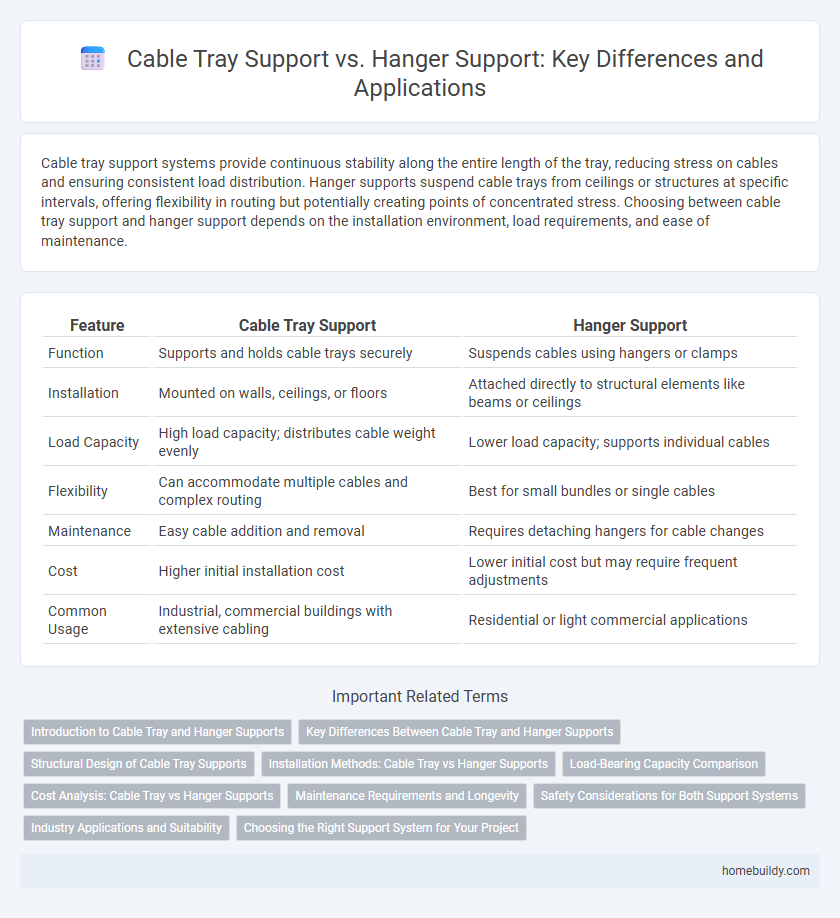Cable tray support systems provide continuous stability along the entire length of the tray, reducing stress on cables and ensuring consistent load distribution. Hanger supports suspend cable trays from ceilings or structures at specific intervals, offering flexibility in routing but potentially creating points of concentrated stress. Choosing between cable tray support and hanger support depends on the installation environment, load requirements, and ease of maintenance.
Table of Comparison
| Feature | Cable Tray Support | Hanger Support |
|---|---|---|
| Function | Supports and holds cable trays securely | Suspends cables using hangers or clamps |
| Installation | Mounted on walls, ceilings, or floors | Attached directly to structural elements like beams or ceilings |
| Load Capacity | High load capacity; distributes cable weight evenly | Lower load capacity; supports individual cables |
| Flexibility | Can accommodate multiple cables and complex routing | Best for small bundles or single cables |
| Maintenance | Easy cable addition and removal | Requires detaching hangers for cable changes |
| Cost | Higher initial installation cost | Lower initial cost but may require frequent adjustments |
| Common Usage | Industrial, commercial buildings with extensive cabling | Residential or light commercial applications |
Introduction to Cable Tray and Hanger Supports
Cable tray supports provide a continuous or modular base for routing electrical cables, ensuring proper cable management and load distribution. Hanger supports suspend cable trays from ceilings or structures, offering flexible positioning and minimizing floor space usage. Both methods enhance cable system organization, but selection depends on installation environment, load capacity, and maintenance accessibility.
Key Differences Between Cable Tray and Hanger Supports
Cable tray supports provide a continuous, rigid base designed to hold multiple cables in an organized manner, ensuring even weight distribution along the tray's length. Hanger supports suspend individual cables or bundles, allowing flexibility in alignment but concentrating stress at specific points. The primary difference lies in load distribution and cable organization: cable trays offer structured support for large cable installations, while hangers provide localized, adaptable suspension for fewer cables.
Structural Design of Cable Tray Supports
Cable tray support systems primarily differ in load distribution and stability, with tray supports providing continuous bearing along the tray's length, enhancing uniform load transfer and reducing stress concentrations. Hanger supports suspend the cable tray at intervals, requiring careful structural design to prevent sagging and ensure load-bearing capacity meets safety standards. Optimal structural design of cable tray supports involves selecting support types based on span length, cable weight, environmental conditions, and compliance with industry standards such as IEEE and IEC.
Installation Methods: Cable Tray vs Hanger Supports
Cable tray supports are typically installed using brackets, clamps, or threaded rods secured to walls, ceilings, or structural frameworks, enabling easy routing and adjustment of cable pathways. Hanger supports rely on suspended rods or straps attached to overhead structures, providing vertical load-bearing capacity but often requiring precise alignment and tensioning during installation. Both methods demand consideration of load capacity, accessibility, and environmental conditions to ensure stable and code-compliant cable management.
Load-Bearing Capacity Comparison
Cable tray support systems offer superior load-bearing capacity compared to hanger support systems due to their continuous and distributed weight distribution design. Hanger supports concentrate loads at specific points, increasing stress on individual hangers and limiting maximum load capacity. Engineering standards often recommend cable trays with robust support frameworks for heavy cable bundles to ensure structural integrity and safety.
Cost Analysis: Cable Tray vs Hanger Supports
Cable tray supports generally offer a more cost-effective solution compared to hanger supports due to simpler installation processes and reduced material requirements. Cable trays minimize labor expenses and maintenance costs by providing easier access for modifications and inspections, while hanger supports often incur higher upfront costs owing to specialized components and complex mounting procedures. Evaluating total lifecycle costs highlights cable trays as the preferred option for large-scale electrical wiring projects seeking budget efficiency.
Maintenance Requirements and Longevity
Cable tray support systems typically require less frequent maintenance compared to hanger supports due to their robust design and easier accessibility for inspections and repairs. Hanger supports often experience increased wear at attachment points, necessitating regular checks to prevent sagging or failure, which can impact cable integrity. The longevity of cable trays is generally superior, as their stable framework minimizes movement and stress on cables, extending the overall lifespan of the cable management infrastructure.
Safety Considerations for Both Support Systems
Cable tray support systems and hanger support systems both prioritize safety through secure load distribution and adherence to industry standards such as NEC and NEMA VE 2. Cable tray supports offer enhanced stability by providing continuous support along the cable run, reducing the risk of cable damage and electrical hazards. Hanger supports require precise load calculations to prevent overloading and maintain clearance from other structures, ensuring fire safety and minimizing mechanical stress on cables.
Industry Applications and Suitability
Cable tray support systems are preferred in industrial applications requiring robust load management and large capacity cable routing, ensuring durability in harsh environments like manufacturing plants and power stations. Hanger supports are suitable for lighter installations and confined spaces, such as commercial buildings or data centers, offering flexibility in vertical cable management. Selection between these supports depends on load capacity, environmental conditions, and installation complexity to optimize cable management efficiency.
Choosing the Right Support System for Your Project
Selecting the right support system for cable trays depends on factors such as load capacity, installation environment, and structural design. Cable tray supports offer continuous support and stability along the tray's length, ideal for heavy-duty applications and long spans. Hanger supports provide point support by suspending trays from ceilings or beams, offering flexibility in height adjustment and minimizing floor space usage in confined areas.
Cable tray support vs Hanger support Infographic

 homebuildy.com
homebuildy.com